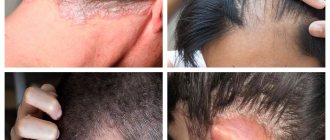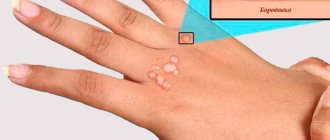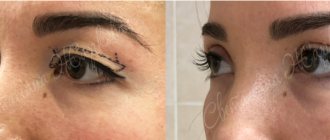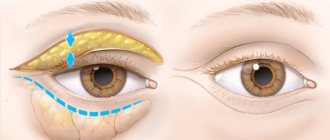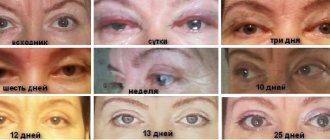In order not to worry about the condition of the skin, the patient needs to clearly understand the processes that occur with him after the operation. Specialists strive to describe the entire procedure in as much detail as possible, as well as the features of the postoperative period that the patient will expect. This helps people relax and trust the doctor more.
Photo from the website of D.R. Grishkyan. There are contraindications, specialist consultation is required
Stages of recovery after blepharoplasty by day:
- 1-2 days – swelling appears and increases within several hours after completion of the operation. The peak situation occurs at the end of the second day. Also, in some cases, hematomas may appear in the cheekbones and temporal area.
- Day 3-4 – swelling gradually decreases. Bruises change their color to yellowish-green.
- 5-7 days – swelling goes away.
- 8-10 days – slight swelling and traces of hematomas may remain. The patient is allowed to return to his usual rhythm of life.
- 20-60 days – you can observe the effect of the procedure. There is a possibility that a slight swelling will persist due to the excess fluid that is still in the tissues.
The speed of recovery after blepharoplasty largely depends on the person’s health. It may vary depending on the individual characteristics of the body.
Beautiful result of upper blepharoplasty in combination with lipofilling of the lower and upper eyelids. Photo from the website of D.R. Grishkyan. There are contraindications, specialist consultation is required
Swelling after blepharoplasty - how to remove it
Plastic surgery – blepharoplasty – can rejuvenate the look and remove wrinkles in the eye area. Although this type of plastic surgery is not complex, after it 95% of patients experience swelling. There is no need to worry about this, because this is a normal option.
Swelling after blepharoplasty - causes
Swelling occurs because during surgery the capillaries of the mucous membrane and skin are traumatized. For this reason, fluid from the vascular bed begins to accumulate in the deep layers of the skin, leading to bruising and swelling. Swelling is also caused by a local inflammatory reaction of the body.
What influences the scale of swelling
- Immunity. If the immune system is strong, then recovery is much faster.
— The patient has chronic diseases. Swelling subsides more slowly if there are health pathologies.
— Swelling also depends on the type of blepharoplasty. The smallest swelling usually occurs after laser, transconjunctival blepharoplasty.
- Age. Patients under 45 years of age have a faster healing rate than those over 45 years of age.
How to relieve swelling after blepharoplasty
Following all the doctor’s recommendations helps reduce swelling.
To increase the healing of skin tissue, you will need to stop drinking alcohol and smoking 2 weeks before and after surgery.
In the first two or three days after surgery, it is advisable to sleep on several pillows, as experts say, this can reduce blood stagnation.
Also, in the first couple of days (sometimes 2-4 days), cold compresses should be applied to the affected area.
Be sure to watch your diet. Caffeine, salty and sweet foods retain fluid in the body, so you should avoid them.
Avoid activities that can cause dry eyes, for example, avoid prolonged viewing of TV, gadgets, and computers.
To reduce swelling, use Sinyakoff, Traumeel and others ointments.
Approximately 7 days after surgery, you can begin a course of physiotherapy and massage treatments, but be sure to consult your doctor first.
On average, swelling after blepharoplasty lasts up to two weeks, and if you follow all the surgeon’s recommendations, healing will be quick and easy!
Swelling after blepharoplasty - reviews
She had eyelid surgery and removed hernias under my eyes. At first it was uncomfortable and the swelling was very noticeable. I followed all the doctor’s recommendations during the rehabilitation period, applied special creams, completely excluded salty foods and everything that retained water in the body. And the swelling subsided very quickly. The main thing is to follow all the doctor’s recommendations!
Tatiana K., Moscow
Photo source - Internet
Sutures after blepharoplasty
Sutures after blepharoplasty are not always applied; for example, with transconjunctival access, a cooling bandage and a patch on the eyelids are sufficient. Thanks to the excellent blood supply to the conjunctiva, the wound heals on its own in the shortest possible time.
If the surgical approach is through skin folds or along the ciliated edge of the eyelid, absorbable suture material is used. Minor scars remain after any operation, but after blepharoplasty they are not visible because they follow natural folds.
Preparations for skin care around the eyes
The technique is based on complex correction with MesoEye™ (USA) and Teosyal PureSense Redensity [II] (Switzerland).
MesoEye™ (USA) is a drug for the prevention and correction of age-related changes in the skin of the periorbital area, simultaneously affecting
three vascular systems - arterial, venous and lymphatic, restoring normal microcirculation in the eyelid area of the upper and lower eyelids.
The drug contains 3 unique components:
- peptide Hexapeptide 17 - C 71, eliminates puffiness around the eyes, activates the outflow of lymph from the eyelid, strengthens the walls of blood vessels, and has an anti-inflammatory effect.
- PeriOrbitalReptide XP2 peptide helps improve blood circulation, relieves vascular spasm, expands capillary walls, restores and protects collagen and elastin fibers from damage;
- DRMC complex (dermal remodeling complex), hyaluronic acid with a complex of amino acids and vitamins moisturizes, tightens, increases skin elasticity, and nourishes blood vessels.
The active components are aimed at strengthening blood vessels and normalizing metabolism in tissues, and also promote hydration and have a rejuvenating effect. The drug has no analogues on the market.
The second injection drug is Teosyal PureSense Redensity [II] (Switzerland), designed to eliminate nasolacrimal grooves and circles under the eyes.
It contains:
- high-density hyaluronic acid, effectively eliminates wrinkles around the eyes and dark circles, regulates the level of skin moisture;
- a dermo-restructuring complex of antioxidants, amino acids, vitamin B6, zinc and copper, protects the area around the eyes from free radicals - substances that disrupt the structure of collagen fibers, starts the process of tissue remodeling and skin rejuvenation.
Together, the components of the drugs form a therapeutic and prophylactic cocktail that can eliminate aesthetic imperfections in just a few procedures.
Complex effect
The drugs complement each other perfectly, allowing the cosmetologist to work in several directions at once - eliminating aesthetic imperfections, normalizing metabolic processes in the area around the eyes and preventing aging of the periorbital zone.
MesoEye™ treatment is carried out over a course, but positive changes can be seen after the first procedure: the skin becomes smoother and more elastic, wrinkles are smoothed out, “bags” and dark circles under the eyes disappear, skin microcirculation is normalized, and the process of skin rejuvenation begins.
The introduction of Teosyal Puresense Redensity II allows you to see the result immediately after completion of the procedure: the skin becomes more elastic, firm and hydrated without dark circles and wrinkles, the eyes no longer look tired and sunken. The rejuvenation effect of the drugs is long-term - the result lasts about a year.
Sign up for a consultation with a specialist
Eyelid surgery without surgery in our aesthetic surgery clinic is performed by plastic surgeon M.A. Osin, who has extensive experience in the field of correction of the skin around the eyes. To find out whether this technique is right for you - blepharoplasty of the lower or upper eyelid without surgery, choose a consultation time that is convenient for you. The doctor will examine your situation and offer the best option for eliminating the problem: non-surgical or surgical. Contact the clinic administrator to make an appointment and find out the prices for non-surgical blepharoplasty.
Despite the fact that non-surgical blepharoplasty is a fairly popular medical service in the field of aesthetic medicine, it is impossible to achieve a long-term effect of skin rejuvenation in the eye area using laser correction and injection techniques. Only plastic surgery - blepharoplasty of the upper and lower eyelids will help make your eyes open and youthful.
The information on the site was personally verified by plastic surgeon Maxim Aleksandrovich Osin; if you have any additional questions, call the phone number listed on the site.
Advantages of the EMC Clinic
The area around the eyes is the most delicate area on the face, requiring special skills and great care from the doctor. If the technique of administering the drug is incorrect and there is insufficient knowledge of anatomy, there is a high risk of the formation of extensive swelling, bruising and contouring of the drug.
Cosmetologists at the EMC clinic have passed mandatory certification to work with injections, have extensive experience in correcting the periorbital area and are fluent in the technique of correct administration of the drug. All EMC patients were satisfied with the results of the procedure.
Features of the technology
In modern aesthetic medicine, several technologies for eyelid lifting without surgery are used: prices in Moscow depend on the choice of method.
Non-surgical plasma blepharoplasty is an innovative technique. Skin tightening occurs under the influence of cold plasma (the fourth state of matter). A plasma arc is formed between the surface of the skin and the needle-shaped attachment.
- During non-surgical eye correction, the skin does not heat up: problem areas are exposed to charged particles, which reduces the risk of skin burns in the upper or lower eyelid area. Under the influence of a plasma device, a very fine fine mesh is formed under the skin, which resembles a lifting effect.
- The fat layer (fatty hernias) is broken down and excess moisture is removed.
- After the regeneration process and rehabilitation period, the condition of the skin in the upper or lower eyelid area improves, wrinkles become smaller.
- This technology is recognized by specialists in the field of aesthetic medicine as one of the most effective and safe correction methods.
- In eliminating upper eyelid hernia, this method is considered the most modern and effective.
The thermolysis method allows you to achieve excellent results after non-surgical blepharoplasty due to the combination of the effects of fractional laser optical thermolysis and RF radiation on the skin. The advantage of this method is that it can be used for patients with different skin conditions and at different ages. The operating parameters of the plexer for non-surgical eyelid lifting are selected individually using a special scanner that reads all the features of a person’s skin.
- This technology allows you to work with moving and fixed eyelids.
- The impact is targeted, so only small areas are treated, which leads to the production of collagen. The skin in the area of the lower or upper eyelid remains intact: rehabilitation after blepharoplasty without surgery is as fast as possible.
- The device generates various types of pulses (D-Pulse and S-Pulse), which cause ablation of skin tissue and deeply warm it up. The combination of two types of waves reduces the exposure time.
- Thanks to the participation of CO2 laser energy, tissue resistance is reduced, and radio frequency waves can penetrate into deeper layers.
- The result of laser exposure is the natural production of collagen, reduction of wrinkles, improvement of skin elasticity, and reduction of pigmentation.
Non-surgical blepharoplasty is also used using electromagnetic waves that heat the deep layers of the skin, causing the collagen fibers to curl. This leads to an increase in skin tone - wrinkles are smoothed out, hernias are eliminated, dark circles under the eyes disappear. Thanks to a special attachment, the skin is treated right up to the edge of the eyelashes: only this technique provides this opportunity.
Non-surgical blepharoplasty of the upper eyelids also includes injection methods: a cocktail of nutrients is injected under the skin using a syringe, which includes plant analogues of human sex hormones, collagen and elastin, vitamins and amino acids. This has a stimulating effect, renewing and tightening the skin.
Regardless of which non-surgical technique is used, it is recommended to undergo a course of procedures: two to four at intervals of one month. This helps to achieve the best effect.
Indications for non-surgical blepharoplasty
- Decreased tone and turgor of the skin around the eyes;
- Pastosity;
- The initial stage of the formation of periorbital hernias;
- Pronounced nasolacrimal and palpebromalar (the area around the eyes, closer to the outer corner of the eyes) grooves;
- Dark circles under the eyes;
- Wrinkles around the eyes (“crow’s feet”);
- Swelling of the eyelids due to impaired lymph flow;
- Rehabilitation of the periorbital area after blepharoplasty.
MesoEye™ (USA) and Teosyal PureSense Redensity [II] injections are perfectly combined with any skincare and hardware procedures.
How is an eyelid lift performed without surgery?
At the first appointment, the doctor examines the patient, collects a complete medical history, finding out whether there are any contraindications to non-surgical lower eyelid blepharoplasty. The doctor evaluates its effectiveness for a particular person. After this, the doctor and the patient decide on non-surgical blepharoplasty or choosing another method. Traditional surgery may be a more appropriate option.
The procedure for lifting an overhanging eyelid without surgery includes several main steps.
- Makeup is completely removed from the face and eyelids.
- An anesthetic – a special gel – is applied to the area around the eyes.
- The eyeball is covered with a protective lens.
- The skin near the eyes is polished.
- The device for non-surgical blepharoplasty is customized according to the individual characteristics of the patient.
- The doctor works with areas where there is excess adipose tissue: it is broken down.
- When the process is complete, the area near the eyes is covered with cold compresses. Subsequently, the patient is asked to use antiseptic ointments to eliminate the risk of infection.
